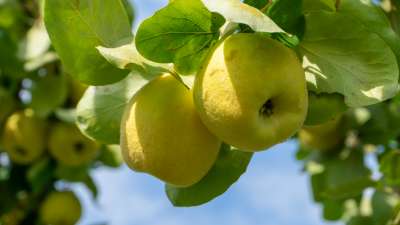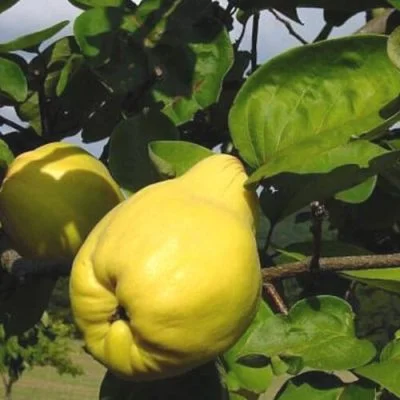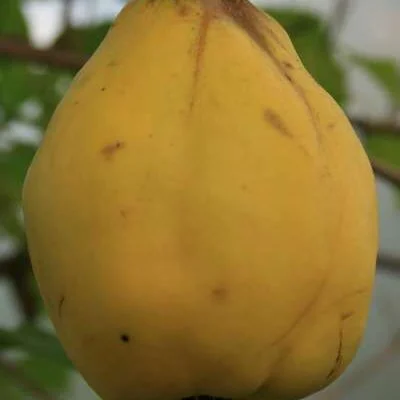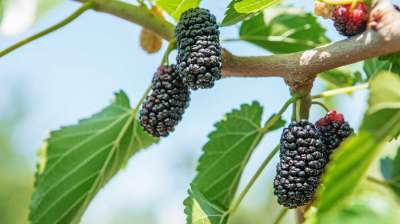Your basket is currently empty!
A section describing the miscelleany of less often grown fruit trees including Quince trees and Medlars, which may interest the more adventurous gardener and those who like to grow something different!.
Quince Tree
Quinces have actually been cultivated for many centuries and have played an important part in ancient history. They seem to be incerasing in popularity, not just because of the resurgent interest in old and traditional fruit trees, but also because they can double as an ornmamental tree in smaller gardens.
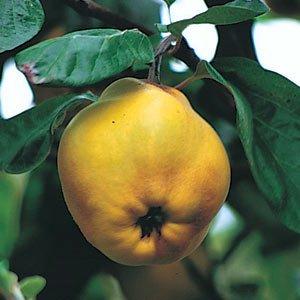
Quince Tree Restricted Size
Quinces just din’t seem to grow that much, and aren’t in any terrible hurry to get there either, so you can plant in a relatively small garden without worry of the tree taking over. An ultimate height of 3-4metres is normal with a spread slightly less.
Quinces Trees Conditions
Known to tolerate wetter soils than many trees so whilst outright waterlogging is still to be avoided, heavier soils, or those near the bottom of a slope can be utilized. Any ordinary soil is fine too and apart from the very alkaline, ph is largely unimportant. They do however prefer a situation with plenty of sun and whilst they are fairly hardy, don’t do well in the far North. Quinces are easy to grow and whilst they can be pruned and trained like a Pear tree [to which they are related] they don’t have to be pruned at all. You may also train a Quince against a sunny wall if liked.
A beautiful aroma – uses of the Quince
Although never grown commercially, the Quince is useful not only as table decoration, but also for making Quince jelly, which is a famed accompaniment to cold meats. They are also added to stewed apples or pears, or apple pie. A well ripened Quince is a glorious thing; large, weighty, slightly downy and dressed in deep golden yellow, it has an enticing perfumed aroma which can scent a room. They are not ripe until November.
Quince Varieties
Vranja and Meech’s Prolific are the only well known varieties of which the former has the largest fruits. Other more obscure varieties you might want to hunt out include Serbian Gold and L’escovatza.
Quince – pollination
All varieties are self fertile so can be grown alone.
Mulberries
A very ancient fruit tree, the first specimens were thought to have been planted by King James I in 17th Century London. Mulberry trees have remained prominent in history and folklore ever since and seem to have a mystique about them. They are not very difficult to grow but they are very slow – you won’t be harvesting fruits for a while.
Growth slow but sure
A Mulberry will not reach fruiting maturity for 7-10 years. These sedate trees aren’t in any hurry to grow but in time they can make substantial specimens so if your’e in this for the long haul, make sure you leave plenty of room. Situating your new Mulberry tree in a large lawn or grassy area, where it can grow undisturbed is a good idea. Happily these are most attractive trees, so before productivity commences you have the value of an ornamental tree. The large fringed leaves turn wonderful shades of golden yellow in the Autumn and the framework can become wonderfully gnarled and characterful.
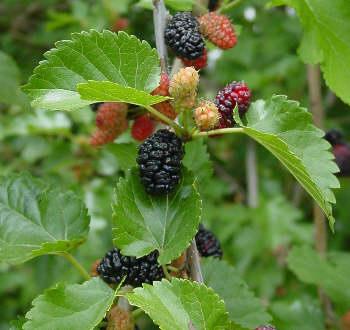
Easy to grow
Mulberries do not have any distinct preferences to soil as long as it is fairly good and you avoid extremes. They are cold hardy and don’t really suffer from disease, nor do they require pruning. You just need the patience of a saint!
Species and varieties
There isn’t a great range to choose from. The Black Mulberry [Morus nigra] is the most commonly grown species and the one most valued for it’s fruits which are loganberry shaped and ripen to a rich reddish black. They bruise very easily and begin to drip juice. They are quite acidic and make wonderful jams and pies as well as freezing very well. The unique flavour can’t be matched by any other fruit. Two varieties of Black Mulberry you might come across are King James [which originates from the King James physic garden in Chelsea] and Black Lady.
Aside from Black Mulberries there are also white [Morus alba] which has sweeter milder fruits and shiny leaves, and red [Morus rubra] a very seldom encountered species from America which is rather like a cross between the black and white species. Weeping Mulberry trees can also be found – Morus alba pendula is an exquisite orjnamerntal tree with steeply pendant waterfall like branches and it does bear a worthwhile crop of pinky white fruits too.
Mulberry trees in pots
It’s quite possible to grow a Mulberry in a largeish container of, say 24-30” and they don’t seem to mind being confined at all. The advantage of this is that it often seems to encourage fruiting earlier in life and reports of fruit being borne from year 5 have been documented.
Mulberries – pollination
Mulberries are all self fertile.
Medlars
Grown by the Greeks and Romans, the fruits of a Medlar arnen’t to be eaten straight from the tree. Infact they really only suit jelly making. Despite this restrictive use, the tree seems to be ascending in popularity. Perhaps it is it’s attractive appearance. The leaves turn to red and orange in the Autumn and the large, single-rose like flowers are also pretty.
Medlars are quite easy to grow and don’t have any soil preferences. They usually start to crop after 2-3 years and won’t get too big – 3-4 metres is usual, when fully mature. A Medlar is a suitable choice for planting in a lawn or large border and is often to be found growing in old Cottage gardens where it seems to have a great afinity.
A warm and sunny position is to be preferred if you intend using the fruits as they take a long time to ripen in the Auutmn.
A limited range of varieties are available of which ‘Nottingham’ is the best fruiting vartiety. You can also still grow the ‘original’ species – Mespilus germanica.
Medlar trees are self fertile so you only need one tree.
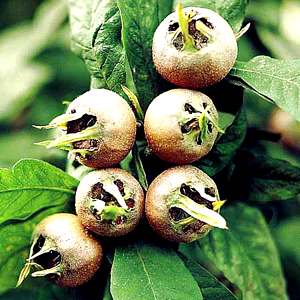
Cherry Plum
Sometimes mistakenly thought of as a cross between a Plum and a Cherry but infact this is a wild tree, all varieties having been derived from Prunus myrobalum cerasifera. Sometimes to be found growing in hedgerows and woodland margins, it can be incorporated in similar ways in the garden or orchard and is a tough, hardy and easily grown tree. The rounded cherry-like fruits are quite sharp and whilst some will eat them straight from the tree, others prefer to make them into jam which is quite delicious.
The tree is very free flowering in early Spring and usually the first fruit tree to open it’s flowers in a dense flurry of snowy white. The habit is quite bushy and freely branching. All varieties are self fertile; varieties are few. ‘de Nancy’ is the most commonly grown and the fruits can be yellow or red. ‘Gipsy’ has fine deep red fruits and ‘Golden Sphere’ is yellow.
Plant 10-12’ apart, less if you want to form an informal hedge.
Asian Pear
Sometimes also called ‘Nashi’ these unusual fruits are sometimes found in Supermarkets. A very strange looking affair, this cross between an apple and a pear really resembles neither entirely. The fruits are circular, like an apple, but have a rough grey-green skin and the inner flesh is crisp but juicier than an apple. The flavour is like a cross between the two.
The trees require a reasonably sheltered position and should be grown and pruned like a Pear. They are quite beautiful with lovely leaves and flowers and older specimens can develop a somewhat drooping habit.
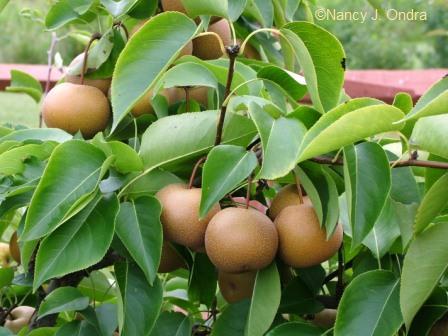
There are few varieties, of which ‘Shinsieki’ is best because it is self pollinating. Others include 20th Century and Chojura.



